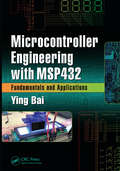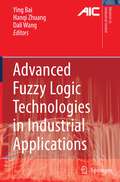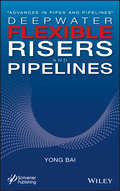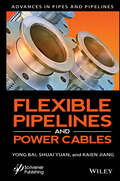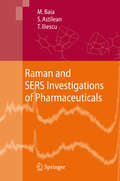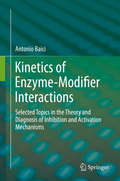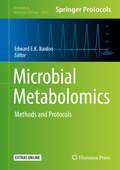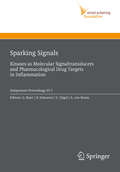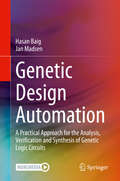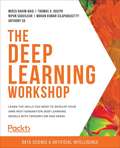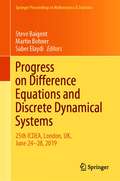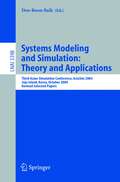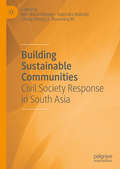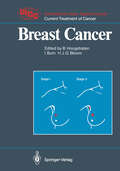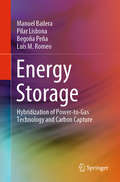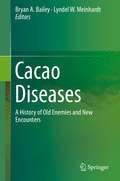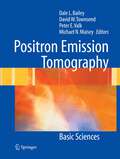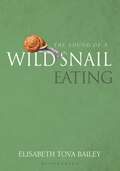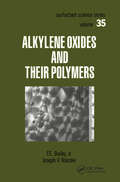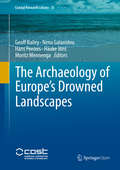- Table View
- List View
Microcontroller Engineering with MSP432: Fundamentals and Applications
by Ying BaiThis book aims to develop professional and practical microcontroller applications in the ARM-MDK environment with Texas Instruments MSP432P401R LaunchPad kits. It introduces ARM Cortex-M4 MCU by highlighting the most important elements, including: registers, pipelines, memory, and I/O ports. With the updated MSP432P401R Evaluation Board (EVB), MSP-EXP432P401R, this MCU provides various control functions with multiple peripherals to enable users to develop and build various modern control projects with rich control strategies. Micro-controller programming is approached with basic and straightforward programming codes to reduce learning curves, and furthermore to enable students to build embedded applications in more efficient and interesting ways. For authentic examples, 37 Class programming projects are built into the book that use MSP432P401R MCU. Additionally, approximately 40 Lab programming projects with MSP432P401R MCU are included to be assigned as homework.
Microcontroller Engineering with MSP432: Fundamentals and Applications
by Ying BaiThis book aims to develop professional and practical microcontroller applications in the ARM-MDK environment with Texas Instruments MSP432P401R LaunchPad kits. It introduces ARM Cortex-M4 MCU by highlighting the most important elements, including: registers, pipelines, memory, and I/O ports. With the updated MSP432P401R Evaluation Board (EVB), MSP-EXP432P401R, this MCU provides various control functions with multiple peripherals to enable users to develop and build various modern control projects with rich control strategies. Micro-controller programming is approached with basic and straightforward programming codes to reduce learning curves, and furthermore to enable students to build embedded applications in more efficient and interesting ways. For authentic examples, 37 Class programming projects are built into the book that use MSP432P401R MCU. Additionally, approximately 40 Lab programming projects with MSP432P401R MCU are included to be assigned as homework.
Advanced Fuzzy Logic Technologies in Industrial Applications (Advances in Industrial Control)
by Ying Bai Hanqi Zhuang Dali WangThis book introduces a dynamic, on-line fuzzy inference system. In this system membership functions and control rules are not determined until the system is applied and each output of its lookup table is calculated based on current inputs. The book describes the real-world uses of new fuzzy techniques to simplify readers’ tuning processes and enhance the performance of their control systems. It further contains application examples.
Deepwater Flexible Risers and Pipelines
by Yong BaiThe technology, processes, materials, and theories surrounding pipeline construction, application, and troubleshooting are constantly changing, and this new series, Advances in Pipes and Pipelines,, has been created to meet the needs of engineers and scientists to keep them up to date and informed of all of these advances. This second volume in the series focuses on flexible pipelines, risers, and umbilicals, offering the engineer the most thorough coverage of the state-of-the-art available. The authors of this work have written numerous books and papers on these subjects and are some of the most influential authors on flexible pipes in the world, contributing much of the literature on this subject to the industry. This new volume is a presentation of some of the most cutting-edge technological advances in technical publishing. The first volume in this series, published by Wiley-Scrivener, is Flexible Pipes, available at www.wiley.com. Laying the foundation for the series, it is a groundbreaking work, written by some of the world’s foremost authorities on pipes and pipelines. Continuing in this series, the editors have compiled the second volume, equally as groundbreaking, expanding the scope to pipelines, risers, and umbilicals. This is the most comprehensive and in-depth series on pipelines, covering not just the various materials and their aspects that make them different, but every process that goes into their installation, operation, and design. This is the future of pipelines, and it is an important breakthrough. A must-have for the veteran engineer and student alike, this volume is an important new advancement in the energy industry, a strong link in the chain of the world’s energy production.
Deepwater Flexible Risers and Pipelines
by Yong BaiThe technology, processes, materials, and theories surrounding pipeline construction, application, and troubleshooting are constantly changing, and this new series, Advances in Pipes and Pipelines,, has been created to meet the needs of engineers and scientists to keep them up to date and informed of all of these advances. This second volume in the series focuses on flexible pipelines, risers, and umbilicals, offering the engineer the most thorough coverage of the state-of-the-art available. The authors of this work have written numerous books and papers on these subjects and are some of the most influential authors on flexible pipes in the world, contributing much of the literature on this subject to the industry. This new volume is a presentation of some of the most cutting-edge technological advances in technical publishing. The first volume in this series, published by Wiley-Scrivener, is Flexible Pipes, available at www.wiley.com. Laying the foundation for the series, it is a groundbreaking work, written by some of the world’s foremost authorities on pipes and pipelines. Continuing in this series, the editors have compiled the second volume, equally as groundbreaking, expanding the scope to pipelines, risers, and umbilicals. This is the most comprehensive and in-depth series on pipelines, covering not just the various materials and their aspects that make them different, but every process that goes into their installation, operation, and design. This is the future of pipelines, and it is an important breakthrough. A must-have for the veteran engineer and student alike, this volume is an important new advancement in the energy industry, a strong link in the chain of the world’s energy production
Flexible Pipelines and Power Cables (Advances in Pipes and Pipelines)
by Yong Bai Shuai Yuan Kaien JiangRaman and SERS Investigations of Pharmaceuticals
by Monica Baia Simion Astilean Traian IliescuOver the last several years it has become apparent to most researchers that interdisciplinary research is the key to success in the sciences’ future. The present book exemplifies such interdisciplinary work. Thus, some new derivatives have been prepared by chemists and consecutively analyzed by physicists in order to better understand their physical-chemical properties for future tests to be performed by pharmacists. The book consists of an introductory section and other eight chapters. First, the fundamentals of infrared, Raman and surface-enhanced Raman spectroscopy and those of the theoretical methods employed for the vibrational prediction modes are highlighted. The SERS investigations illustrated in the following chapters are focused on different kinds of drugs: tranquilizers and sedatives, anti-inflammatory drugs, vitamins, drugs with anti-bacterial properties, etc. Since there is an increased interest in designing highly effective and controllable SERS-active substrates, a few newly developed substrates that could contribute to a deeper understanding and knowledge of the adsorption behavior of various types of molecules of pharmaceutical and medical interest are also presented.
Kinetics of Enzyme-Modifier Interactions: Selected Topics in the Theory and Diagnosis of Inhibition and Activation Mechanisms
by Antonio BaiciThe kinetic mechanisms by which enzymes interact with inhibitors and activators, collectively called modifiers, are scrutinized and ranked taxonomically into autonomous species in a way similar to that used in the biological classification of plants and animals. The systematization of the mechanisms is based on two fundamental characters: the allosteric linkage between substrate and modifier and the factor by which a modifier affects the catalytic constant of the enzyme. Combinations of the physically significant states of these two characters in an ancestor-descendant-like fashion reveal the existence of seventeen modes of interaction that cover the needs of total, partial and fine-tuning modulation of enzyme activity. These interactions comprise five linear and five hyperbolic inhibition mechanisms, five nonessential activation mechanisms and two hybrid species that manifest either hyperbolic inhibition or nonessential activation characteristics depending on substrate concentration. Five essential activation mechanisms, which are taxonomically independent of the mentioned basic species, complete the inventory of enzyme modifiers. Often masked under conventional umbrella terms or treated as anomalous cases, all seventeen basic inhibition and nonessential activation mechanisms are represented in the biochemical and pharmacological literature of this and the past century, either in the form of rapid or slow-onset reversible interactions, or as irreversible modification processes.The full potential of enzyme inhibitors and activators can only be appreciated after elucidating the details of their kinetic mechanisms of action exploring the entire range of physiologically significant reactant concentrations. This book highlights the wide spectrum of allosteric enzyme modification in physiological occurrences as well as in pharmacological and biotechnological applications that embrace simple and multiple enzyme-modifier interactions. The reader is guided in the journey through this still partly uncharted territory with the aid of mechanistically-oriented criteria aimed at showing the logical way towards the identification of a particular mechanism.
Explosive Boiling of Superheated Cryogenic Liquids
by Vladimir G. BaidakovThe monograph is devoted to the description of the kinetics of spontaneous boiling of superheated liquefied gases and their solutions. Experimental results are given on the temperature of accessible superheating, the limits of tensile strength of liquids due to processes of cavitation and the rates of nucleation of classical and quantum liquids. The kinetics of evolution of the gas phase is studied in detail for solutions of cryogenic liquids and gas-saturated fluids. The properties of the critical clusters (bubbles of critical sizes) of the newly evolving gas phase are analyzed for initial states near the equilibrium coexistence curves of liquid and gas, for states near the limits of accessible superheating and for initial states near the respective spinodal curves. Finally, processes of explosive boiling of cryogenic liquids are considered occurring as the result of outflow processes and intensive interactions with high-temperature liquid samples.
Microbial Metabolomics: Methods and Protocols (Methods in Molecular Biology #1859)
by Edward E. K. BaidooThis detailed volume includes protocols that represent the breadth of microbial metabolomics approaches to both large-scale and small-scale experiments with intention of highlighting techniques that can be used for applications ranging from environmental microbiology to human disease. Utilizing mass spectrometry as their primary measurement tool, the chapters explore microbial metabolomics, metabolism and microbial physiology, metabolite sample preparation, current analytical techniques used to profile primary and secondary metabolites and lipids, as well as establishing data analysis workflows for targeted metabolomics, untargeted metabolomics, analysis of metabolic fluxes, and genome-scale models. Written for the highly successful Methods in Molecular Biology series, chapters include introduction to their respective topics, lists of the necessary materials and reagents, step-by-step readily reproducible protocols, and tips on troubleshooting and avoiding known pitfalls.Authoritative and practical, Microbial Metabolomics: Methods and Protocols serves as an ideal reference for both novice and advanced users and can be adapted to similar analytical platforms or customized to suit the needs of the researcher.
Sparking Signals: Kinases as Molecular Signaltransducers and Pharmacological Drug Targets in Inflammation (Ernst Schering Foundation Symposium Proceedings #2007/3)
by G. Baier B. Schraven U. Zügel A. Von BoninThe importance of the protein kinase family is underscored by numerous disease states that arise due to dysregulation of kinase activity. Recent progress in understanding the molecular regulation of kinases has led to the development of new therapeutics based on the inhibition of kinase activity. In this book, well known experts present their most recent findings on the fast developing kinase field. It will be of interest to basic researchers and the pharmaceutical industry.
Freiraum und Naturschutz: Die Wirkungen von Störungen und Zerschneidungen in der Landschaft
by Hermann Baier Frithjof Erdmann Rainer Holz Arno WaterstraatFlächenverbrauch sowie Störungen und Zerschneidungen in der Landschaft führen für viele Tier- und Pflanzenarten zu einschneidenden Konsequenzen. Erhöhte Mortalität, Dezimierung von Lebensräumen, verringerter Genaustausch und Verinselung der Restpopulationen erfordern eine weit über die einzelne Population oder den einzelnen Biotop hinausgehende Betrachtungsweise. Durch Verknüpfung von geographischen, verhaltensbiologischen und populationsökologischen Ansätzen wird hier erstmals ein geschlossener Überblick über das Thema vorgelegt. Anhand von Beispielen werden die Einflüsse von Störungen und in den einzelnen Wirkebenen wie Verhalten, Habitatnutzung und Population erläutert. Schlussfolgerungen für die Umwelt-, Landschaftsplanung, den Artenschutz und die Eingriffsregelung bieten neben der Vermittlung eines in sich geschlossenen Theoriegebäudes auch dem Praktiker im Naturschutz eine wertvolle Hilfe für die tägliche Arbeit.
Genetic Design Automation: A Practical Approach for the Analysis, Verification and Synthesis of Genetic Logic Circuits
by Hasan Baig Jan MadsenThis textbook introduces readers to the recent advances in the emerging field of genetic design automation (GDA). Starting with an introduction and the basic concepts of molecular biology, the authors provide an overview of various genetic design automation tools. The authors then present the DVASim tool (Dynamic Virtual Analyzer and Simulator) which is used for the analysis and verification of genetic logic circuits. This includes methods and algorithms for the timing and threshold value analyses of genetic logic circuits. Next, the book presents the GeneTech tool (A technology mapping tool for genetic circuits) and the methods developed for optimization, synthesis, and technology mapping of genetic circuits. Chapters are followed by exercises which give readers hands-on practice with the tools presented. The concepts and algorithms are thoroughly described, enabling readers to improve the tools or use them as a starting point to develop new tools. Both DVASim and GeneTech are available from the developer’s website, free of charge. This book is intended for a multidisciplinary audience of computer scientists, engineers and biologists. It provides enough background knowledge for computer scientists and engineers, who usually do not have any background in biology but are interested to get involved in this domain. This book not only presents an accessible basic introduction to molecular biology, it also includes software tools which allow users to perform laboratory experiments in a virtual in-silico environment. This helps newbies to get a quick start in understanding and developing genetic design automation tools. The third part of this book is particular useful for biologists who usually find it difficult to grasp programming and are reluctant to developing computer software. They are introduced to the graphical programming language, LabVIEW, from which they can start developing computer programs rapidly. Readers are further provided with small projects which will help them to start developing GDA tools.
The Deep Learning Workshop: Learn The Skills You Need To Develop Your Own Next-generation Deep Learning Models With Tensorflow And Keras
by Mirza Rahim Baig Thomas V. Joseph Nipun Sadvilkar Mohan Kumar Silaparasetty Anthony SoAre you fascinated by how deep learning powers intelligent applications such as self-driving cars, virtual assistants, facial recognition devices, and chatbots to process data and solve complex problems? Whether you are familiar with machine learning or are new to this domain, The Deep Learning Workshop will make it easy for you to understand deep learning with the help of interesting examples and exercises throughout. The book starts by highlighting the relationship between deep learning, machine learning, and artificial intelligence and helps you get comfortable with the TensorFlow 2.0 programming structure using hands-on exercises. You'll understand neural networks, the structure of a perceptron, and how to use TensorFlow to create and train models. The book will then let you explore the fundamentals of computer vision by performing image recognition exercises with convolutional neural networks (CNNs) using Keras. As you advance, you'll be able to make your model more powerful by implementing text embedding and sequencing the data using popular deep learning solutions. Finally, you'll get to grips with bidirectional recurrent neural networks (RNNs) and build generative adversarial networks (GANs) for image synthesis. By the end of this deep learning book, you'll have learned the skills essential for building deep learning models with TensorFlow and Keras.
Progress on Difference Equations and Discrete Dynamical Systems: 25th ICDEA, London, UK, June 24–28, 2019 (Springer Proceedings in Mathematics & Statistics #341)
by Steve Baigent Martin Bohner Saber ElaydiThis book comprises selected papers of the 25th International Conference on Difference Equations and Applications, ICDEA 2019, held at UCL, London, UK, in June 2019. The volume details the latest research on difference equations and discrete dynamical systems, and their application to areas such as biology, economics, and the social sciences. Some chapters have a tutorial style and cover the history and more recent developments for a particular topic, such as chaos, bifurcation theory, monotone dynamics, and global stability. Other chapters cover the latest personal research contributions of the author(s) in their particular area of expertise and range from the more technical articles on abstract systems to those that discuss the application of difference equations to real-world problems. The book is of interest to both Ph.D. students and researchers alike who wish to keep abreast of the latest developments in difference equations and discrete dynamical systems.
Systems Modeling and Simulation: Third Asian Simulation Conference, AsiaSim 2004, Jeju Island, Korea, October 4-6, 2004, Revised Selected Papers (Lecture Notes in Computer Science #3398)
by Doo-Kwon BaikBuilding Sustainable Communities: Civil Society Response in South Asia
by Rajendra Baikady Md. Nurul Momen Cheng Sheng Li M. BasavarajThe book aims to explore South Asian third sector – the nonprofit organizations as provider of social services. The book defines social welfare and describe its relationship to social service programmes and individual well-being; understands the social policy development from the problem identification to policy implementation; describes the range of organization of social service agencies that are responsible for providing social welfare programmes; explores the various roles that professional and non- professional helpers provide in the delivery of social welfare and their influence in promoting change in policy development; and understands the umbrella concept of Child welfare, welfare of people with disability and elderly welfare in welfare policy.
Breast Cancer (UICC Current Treatment of Cancer)
by J. C. Bailar H. Bohmert G. Bonadonna C. Brambilla T. A. Broughan S. K. Carter J. Chamberlain C.B.Jr. Esselstyn L. Grimard B. M. Healey E. Heise J. Holland S. A. Hundahl J. R. Yarnold W. L. McGuire C. K. Osborne M. P. Osborne B. Pierquin J. Rowland R. A. Saez E. Shakin S. Shousa E. M. Smith H. J. Tagnon D. C. Tormey J. A. Urban P. ValagussaThis series on the treatment of cancer is sponsored by the UICC. The editors and authors feel strongly that more standar dization in cancer therapy is needed on a worldwide basis. This, of course, is only possible if experts from all countries subscribe to a joint policy of making their treatment designs available 'to practising oncologists all over the world. Current Treatment of Cancer discusses all the equipment and methods now in use in cancer therapy. It covers all types of cancer, thus providing the reader with comprehensive infor mation on cancer management. In recent decades there has been a tremendous improve ment in the treatment of cancer, and there is hope for even fur ther success in this fight. We are convinced that this series will help us to make a concerted response to the challenge of can cer. UICC Treatment and Rehabilitation Programme Ismail Elsebai Chairman 1988 IX Preface With a subject as complicated and sensitive as breast cancer, the concept of producing a book which reflects all opinion on the topic is daunting.
Energy Storage: Hybridization of Power-to-Gas Technology and Carbon Capture (Springerbriefs In Energy Ser.)
by Manuel Bailera Pilar Lisbona Begoña Peña Luis M. RomeoThis book presents a detailed analysis of Power-to-Gas, a promising energy storage technology. It discusses the main mechanisms involved, and presents two Power-to-Gas and carbon capture hybridizations. The book begins by providing an introduction to energy storage technologies. It then reviews a number of Power-to-Gas projects now in progress, highlighting the current barriers to commercializing the technology. Moreover, the book presents two novel Power-to-Gas hybridizations, which improve the technology’s applicability in terms of efficiency, utilization of resources and profitability. Given its scope, the book will be of interest to graduate students, researchers and practitioners in the fields of engineering and energy.
Cacao Diseases: A History of Old Enemies and New Encounters
by Bryan A. Bailey Lyndel W. MeinhardtThis book reviews the current state of knowledge concerning cacao pathogens and methods for their management. Topics discussed include the history, biology and genetic diversity of Moniliophthora species (which cause witches’ broom and frosty pod rot) and Phytophthora species (which cause black pod rot) that cause diseases resulting in major losses to cacao production. Emerging pathogens such as Cacao swollen shoot virus and Ceratobasidium theobromae (which causes vascular streak dieback) are also discussed in detail, along with many pathogens of significant local concern. Most of these pathogens represent major risks to global cacao production should they expand into new areas, breaking out of their current limited distributions. By considering cacao diseases as a group, similarities in the available tools and techniques used in their management become apparent, as do their limitations. Gaps in our current knowledge of cacao pathogens and the management of the diseases they cause are detailed, and suggestions for future research directions are provided. This insight allows readers to consider cacao disease threats from a more comprehensive, global perspective and paves the way for an improved synergy of efforts between the various research programs, agencies, and industries, both private and public, with vested interests in cacao production, and cacao farmers.
Positron Emission Tomography: Basic Sciences
by Dale L. Bailey David W. Townsend Peter E. Valk Michael N. MaiseyEssential for students, science and medical graduates who want to understand the basic science of Positron Emission Tomography (PET), this book describes the physics, chemistry, technology and overview of the clinical uses behind the science of PET and the imaging techniques it uses. In recent years, PET has moved from high-end research imaging tool used by the highly specialized to an essential component of clinical evaluation in the clinic, especially in cancer management. Previously being the realm of scientists, this book explains PET instrumentation, radiochemistry, PET data acquisition and image formation, integration of structural and functional images, radiation dosimetry and protection, and applications in dedicated areas such as drug development, oncology, and gene expression imaging. The technologist, the science, engineering or chemistry graduate seeking further detailed information about PET, or the medical advanced trainee wishing to gain insight into the basic science of PET will find this book invaluable. This book is primarily repackaged content from the Basic Science section of the 'big' Valk book on PET. It contains new, completely revised and unchanged chapters covering the "basic sciences" section of the main book - total 18 chapters: 2 new (chapters 1, 16) 8 completely revised (chapters 4, 5, 8, 13, 14, 15, 17, 18) 3 minor corrections (chapters 2, 6, 11) 5 unchanged (chapters 3, 7, 9, 10, 12)
The Sound of a Wild Snail Eating
by Elisabeth Tova BaileyThe delightful account of how a close connection with nature brought joy to a woman incapacitated through illness.While an illness keeps her bedridden, Elisabeth Bailey watches a wild snail that has taken up residence in a terrarium alongside her bed. She enters the rhythm of life of this mysterious creature, and comes to a greater understanding of her own confined place in the world. In a work that beautifully demonstrates the rewards of closely observing nature, she shares the inspiring and intimate story of her close encounter with Neohelix albolabris – a common woodland snail.Intrigued by the snail's world – from its strange anatomy to its mysterious courtship activities – she becomes a fascinated and amused observer of the snail's curious life. The Sound of a Wild Snail Eating is an affirmation of the healing power of nature, revealing how much of the world we miss in our busy daily lives, and how truly magical it is.A remarkable journey of survival and resilience, The Sound of a Wild Snail Eating shows how a small part of the natural world can illuminate our own human existence and deepen our appreciation of what it means to be fully alive.
Alkylene Oxides and Their Polymers
by F.E. Bailey Joseph V. KoleskeA comprehensive treatment of a large family of polymers useful in a wide range of applications in such fields as automotive, pharmaceutical, cosmetic, metal-working, mining, industrial coating, textile, construction, and home furnishings. Summarizes the chemistry and mechanisms; provides basic prepa
Alkylene Oxides and Their Polymers
by F.E. Bailey Joseph V. KoleskeA comprehensive treatment of a large family of polymers useful in a wide range of applications in such fields as automotive, pharmaceutical, cosmetic, metal-working, mining, industrial coating, textile, construction, and home furnishings. Summarizes the chemistry and mechanisms; provides basic prepa
The Archaeology of Europe’s Drowned Landscapes (Coastal Research Library #35)
by Geoff Bailey Nena Galanidou Hans Peeters Hauke Jöns Moritz MennengaThis open access volume provides for the first time a comprehensive description and scientific evaluation of underwater archaeological finds referring to human occupation of the continental shelf around the coastlines of Europe and the Mediterranean when sea levels were lower than present. These are the largest body of underwater finds worldwide, amounting to over 2500 find spots, ranging from individual stone tools to underwater villages with unique conditions of preservation. The material reviewed here ranges in date from the Lower Palaeolithic period to the Bronze Age and covers 20 countries bordering all the major marine basins from the Atlantic coasts of Ireland and Norway to the Black Sea, and from the western Baltic to the eastern Mediterranean. The finds from each country are presented in their archaeological context, with information on the history of discovery, conditions of preservation and visibility, their relationship to regional changes in sea-level and coastal geomorphology, and the institutional arrangements for their investigation and protection. Editorial introductions summarise the findings from each of the major marine basins. There is also a final section with extensive discussion of the historical background and the legal and regulatory frameworks that inform the management of the underwater cultural heritage and collaboration between offshore industries, archaeologists and government agencies. The volume is based on the work of COST Action TD0902 SPLASHCOS, a multi-disciplinary and multi-national research network supported by the EU-funded COST organisation (European Cooperation in Science and Technology). The primary readership is research and professional archaeologists, marine and Quaternary scientists, cultural-heritage managers, commercial and governmental organisations, policy makers, and all those with an interest in the sea floor of the continental shelf and the human impact of changes in climate, sea-level and coastal geomorphology.
